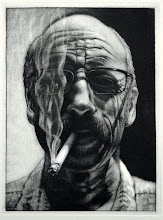The S240 group began the semester by picking out an abandoned plate from a previous semester, pulling a proof of the plate, and then selecting a 4" x 6" section of the image to transform into another image but also utilizing part of the original image. After they found the area to work with, they cut the plate, cropping down to the 4 by 6 section. Learning how to utilize their scraper and burnishing tools, they removed the part of the metal plate they wanted to transform, and then added additional imagery by etching in line work, aquatint, soft ground. By pulling working proofs of their plates in progress, they also learned how to ink and wipe intaglio plates, and print on the etching presses. The below selections were particularly successful in transforming the original zinc plates into new matrixes that yielded some pretty interesting impressions. You can click on the images for greater detail.
 This is Troy's reworked intaglio plate, with the original impression on the right and the new version on the left. He did a lot of scraping, sugar lift, aquatint, and line etch, transforming the image from the crouched figure to an "A-Bomb." If you look closely at the background, you'll see the mountain range he included in his image.
This is Troy's reworked intaglio plate, with the original impression on the right and the new version on the left. He did a lot of scraping, sugar lift, aquatint, and line etch, transforming the image from the crouched figure to an "A-Bomb." If you look closely at the background, you'll see the mountain range he included in his image. Tatum pulled some existing shapes out of the heavily etched plate, the original impression is on the bottom, she did some scraping and burnishing and then some open-bite to create an abstract pattern of positives and negatives.
Tatum pulled some existing shapes out of the heavily etched plate, the original impression is on the bottom, she did some scraping and burnishing and then some open-bite to create an abstract pattern of positives and negatives. Pako found in his original impression, the bottom image, a car buried in lots of dark texture. He pulled that out with scraping, burnishing, and sanding, and then added some text and additional imagery.
Pako found in his original impression, the bottom image, a car buried in lots of dark texture. He pulled that out with scraping, burnishing, and sanding, and then added some text and additional imagery. Daphne selected a deeply etched plate of shapes suggesting fingers, the bottom impression. There was a lot of open-bite, so she continued with that approach by adding imagery of a "polaroid" shape and some vine, and added a subtle aquatint into the image area of the polaroid.
Daphne selected a deeply etched plate of shapes suggesting fingers, the bottom impression. There was a lot of open-bite, so she continued with that approach by adding imagery of a "polaroid" shape and some vine, and added a subtle aquatint into the image area of the polaroid. Danny found a skull buried in this deeply etched plate, bottom impression, and used his scraper and burnisher to bring out that feature. Then he got rid of all the other information by scraping, burnishing, and sanding. After getting the plate back to a nearly clean surface, he added another scull and other shapes set off by a lightly etched aquatint.
Danny found a skull buried in this deeply etched plate, bottom impression, and used his scraper and burnisher to bring out that feature. Then he got rid of all the other information by scraping, burnishing, and sanding. After getting the plate back to a nearly clean surface, he added another scull and other shapes set off by a lightly etched aquatint.

2 comments:
This was fun. The new one I'm feeling pressure with. Any little mistake feels out of control.
So far, I'm feeling more relaxed and enjoying the relief process more.
Don't think of them as mistakes, Connie, think of them as learning experiences. Printmaking requires to some extent a plan of action, and when the plan is nebulous, the results of any action can sometimes require a little back-tracking.
Post a Comment